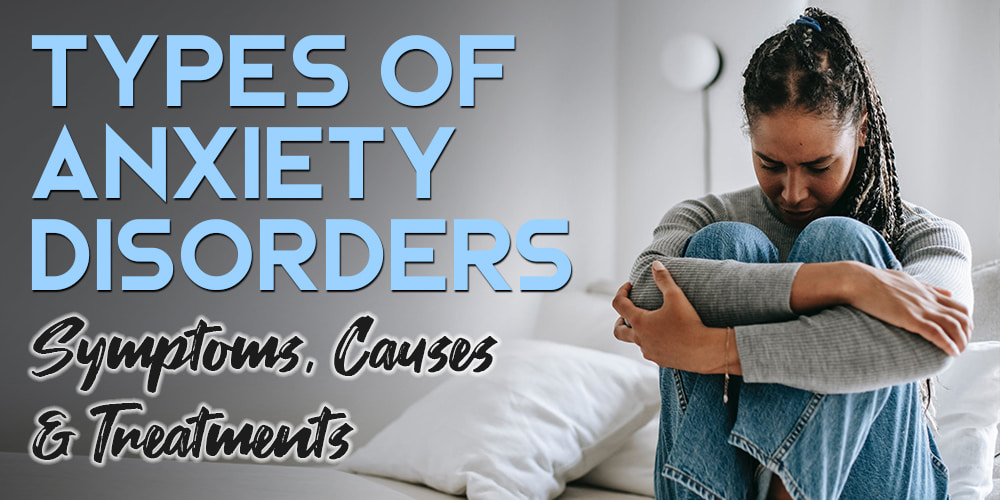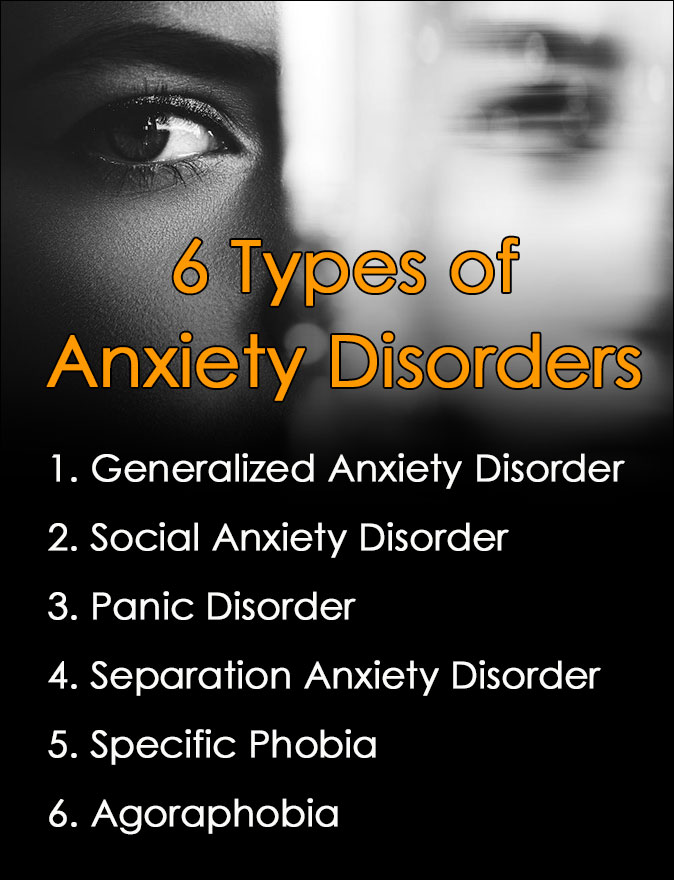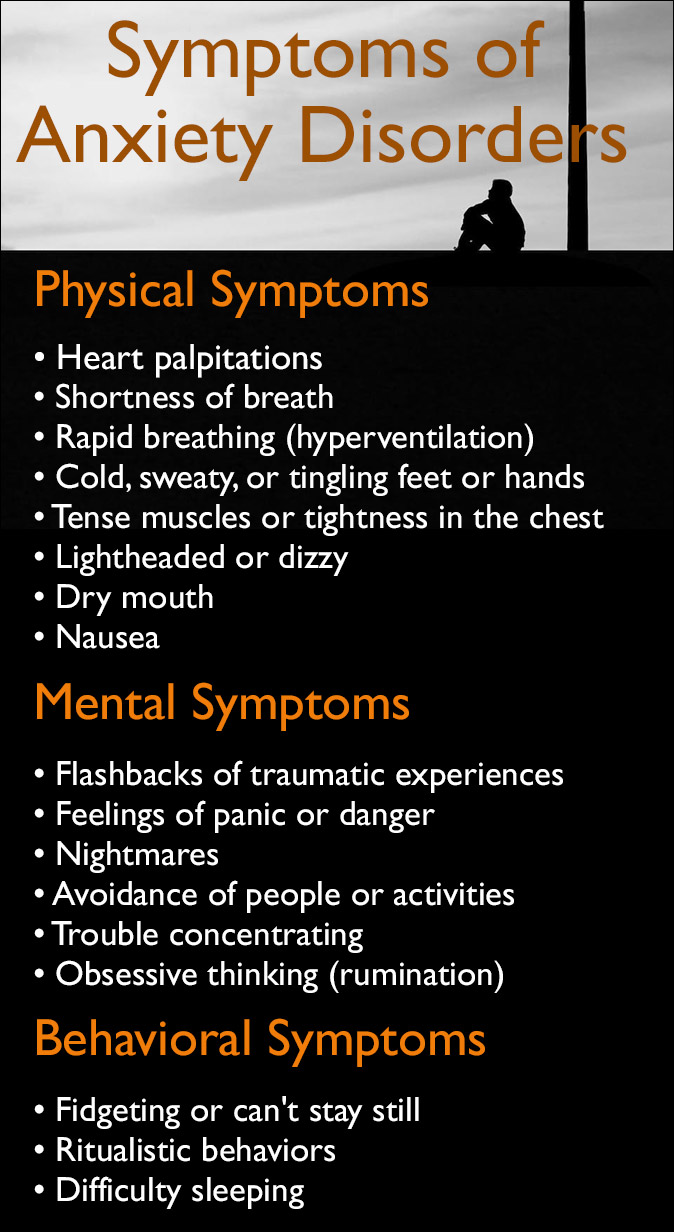
Everyone experiences some form of anxiety once in a while, but when it becomes a chronic condition that leads to one of the six types of anxiety disorders, it’s often necessary to seek treatment.
If left untreated, anxiety disorders can become unmanageable and lead to depression or a co-occurring disorder of mental health and addiction.
What are Anxiety Disorders?
Anxiety disorders are a mental health condition related to an emotional response that has both psychological and physiological implications.
Anxiety activates the body’s “fight or flight” response, which is a natural reaction to perceived danger.
When a person encounters stress, such as a looming deadline, a difficult conversation, or an upsetting event, the body’s stress response kicks in, releasing hormones such as adrenaline and cortisol.
These hormones cause the heart to race, breathing to quicken, and muscles to tense up – all in preparation to respond to the perceived threat.
Although anxiety is a normal response to a stressful event, it can be problematic when it becomes persistent, pervasive, and impacts a person’s ability to function normally in daily life.
According to John Hopkins Medicine, anxiety disorders are a class of mental illness that affect nearly 18 percent of people between the ages 18 to 54 in any given year.
The symptoms can vary widely depending on the specific types of anxiety disorders.
6 Types of Anxiety Disorders
Anxiety disorders are a group of mental health conditions characterized by persistent feelings of fear, worry, or apprehension that often interfere with daily activities and quality of life.
There are different types of anxiety disorders, each with unique triggers and symptoms that can complicate an individual’s daily functioning.
Understanding the various types of anxiety disorders can help people recognize the signs and seek appropriate treatment.

Six Types of Anxiety Disorders Include:
1. Generalized Anxiety Disorder
Generalized Anxiety Disorder is characterized by an overwhelming and unrealistic sense of worry and tension that persists despite the absence of a discernible cause.
Those who experience this type of anxiety disorder often find themselves excessively preoccupied with everyday activities and events typically regarded as routine or ordinary.
The level of concern and constant worry can be disproportionate to the actual circumstances and is often challenging to manage, resulting in physical symptoms such as fatigue, pain, or shortness of breath.
It is not uncommon for Generalized Anxiety Disorder to co-occur with other mental health conditions such as panic disorder, obsessive-compulsive disorder, depression, or addiction.
2. Social Anxiety Disorder
Social Anxiety Disorder, which is also known as Social Phobia, is a condition that goes beyond mere shyness. Instead, it’s a pervasive feeling of worry and self-consciousness that can significantly affect a person’s life.
Those who experience this type of anxiety disorder may obsessively worry about how others perceive them, or fear being judged or ridiculed.
With Social Anxiety Disorder, anxiety levels can be so intense that a person avoids social situations altogether. As a result, this disorder can significantly affect a person’s day-to-day life, making it hard to connect with others and feel comfortable in their own skin.
Given the nature of this type of condition it is ironic that there are so many celebrities with anxiety and social phobia.
3. Panic Disorder
Panic Disorder is a serious condition that can cause an individual to experience an intense fear that produces a full-blown panic attack.
Panic attack symptoms may include a pounding heart, sweating, and a sensation of impending doom. It is an overwhelming experience that cannot easily be dismissed.
In addition, Panic Disorder is often characterized by repeated episodes of panic attacks, which can leave a person feeling on edge all the time as they begin to fear the panic attack itself. Some may even avoid situations they fear could trigger another attack, making it challenging to live a healthy life.
4. Separation Anxiety Disorder
Separation Anxiety Disorder is a condition that can create significant challenges for those who struggle with it on a regular basis.
The excessive fear and anxiety that accompany Separation Anxiety Disorder can be debilitating and can cause a person to feel trapped and isolated, leading to depression and other mental health issues.
While it’s true that Separation Anxiety Disorder is usually thought of as a childhood condition, it can affect people of all ages.
The constant worry and fear of something terrible happening to a loved one can lead to physical symptoms such as nausea, headaches, and sleep disturbances.
Seeking treatment for Separation Anxiety Disorder is essential to improving a person’s quality of life and his or her ability to form and maintain healthy relationships.
With the proper support and care, individuals with this disorder can learn coping strategies and techniques to effectively manage the symptoms.
5. Specific Phobia
Specific Phobia is a common type of anxiety disorder that can affect anyone. The fear of a particular object, event, or situation is so intense that it causes a person to experience physical symptoms such as sweating, trembling, and increased heart rate.
In some cases, the symptoms become so extreme that they interfere with a person’s ability to function normally.
A Specific Phobia anxiety disorder can arise from a variety of factors, including genetics, environment, and life experiences.
For example, a person who had a traumatic experience involving dogs may develop a phobia of dogs. Alternatively, a person may develop a phobia of heights after watching a loved one fall from a high place.
An individual with Specific Phobia may go to great lengths to avoid the circumstances or object that triggers his or her fear, leading to a reduced quality of life.
In addition, the fear can be so intense that it affects a person’s personal and professional relationships, leading to social isolation or even job loss.
6. Agoraphobia
Agoraphobia is a debilitating type of anxiety disorder that impacts a person’s mental and physical health, social life, and work.
The fear of being trapped where escape or help may not be possible can cause extreme anxiety and lead to avoidance behaviors that limit a person’s activities and interactions with others.
Examples of this include the fear of being in a crowd of people, stuck on public transportation, or even being in an enclosed public space.
As a result, it’s common for people with agoraphobia to feel isolated and alone as they struggle to attend social events, work, or even run errands. These limitations may lead to feelings of depression, frustration, and hopelessness, as well as making it difficult for individuals to seek help and support.
Other Types of Anxiety Disorders
There are several other conditions which some consider as types of anxiety disorders, although they have either moved to a different category or have special requirements.
Medication-Induced Anxiety Disorder is a form of anxiety caused by the use of legal or illegal drugs. If an individual already had anxiety before using the drug or medication, though, it would not be considered medication-induced anxiety.
Obsessive Compulsive Disorder (OCD) and Post-Traumatic Stress Disorder (PTSD) were previously considered to be types of anxiety disorders, although the DSM-5 re-classified them into separate categories.
Symptoms of Anxiety Disorders
The main symptoms of anxiety disorders are excessive fear or worry, although there is a range of symptoms that vary from person to person and from disorder to disorder.
Other types of anxiety disorder symptoms include racing thoughts, muscle tension, irritability, difficulty concentrating, and difficulty sleeping.
These symptoms often make it challenging to complete everyday tasks and may significantly affect a person’s quality of life.
It should be noted that the symptoms of anxiety disorders can be physical, mental, or behavioral issues.

Common Physical Symptoms of Anxiety Disorders
- Heart palpitations
- Shortness of breath
- Rapid breathing (hyperventilation)
- Cold, sweaty, or tingling feet or hands
- Tense muscles or tightness in the chest
- Lightheaded or dizzy
- Dry mouth
- Nausea
Mental Symptoms of Anxiety Disorders
- Flashbacks of traumatic experiences
- Feelings of panic or danger
- Nightmares
- Avoidance of people or routine activities
- Trouble concentrating
- Obsessively thinking about a problem and being unable to stop (rumination)
Behavioral Anxiety Symptoms
- Fidgeting or inability to stay still
- Ritualistic behaviors
- Difficulty sleeping or sleep problems
Causes of Anxiety Disorders
It can be difficult to understand the exact causes of the various types of anxiety disorders for each individual.
In general, types of anxiety disorders may be caused by some of the following:
- Medical conditions
- Environmental factors
- Stress
- Genetics
- Drug or alcohol misuse or withdrawal
- Brain chemistry
If a medical condition is suspected of causing anxiety, a doctor may order tests to investigate further.
Anxiety symptoms can be an indicator of an underlying medical condition, such as diabetes, chronic pain, disease, respiratory disorders, or tumors.
The side effects of some medications can cause anxiety.
Risk factors for anxiety disorders include:
- Trauma
- Stress from an illness or life events
- Certain personality types
- Having relatives with anxiety disorders
- Co-occurring mental health disorders such as depression
- Drug or alcohol dependence and addiction
Anxiety Disorder Treatments
Different types of anxiety disorders require appropriate treatment and cannot be willed away through self-discipline.
Anxiety and addiction treatment together is often necessary when co-occurring disorders are present.
Treatment plans for anxiety disorders can include a combination of medication, therapy, and self-care.
Medications
Medications for some types of anxiety disorders may be needed, at least temporarily to stabilize the condition.
Some anxiety medications can be effective on their own and usually work even better when combined with cognitive and behavioral therapies.
Medications used for anxiety include:
- Alprazolam (Xanax)
- Lorazepam (Ativan)
- Diazepam (Valium)
- Sertraline (Zoloft)
- Paroxetine (Paxil)
- Fluvoxamine (Luvox)
- Propranolol (Inderal)
- Atenolol (Tenormin),
- Gabapentin (Neurontin)
- Pregabalin (Lyricas)
- Aripiprazole (Abilify)
- Quetiapine (Seroquel)
- Buspirone
Therapy
There are a number of evidence-based treatment therapies that can be used to successfully treat anxiety disorders.
Therapies used for anxiety include:
Cognitive Behavioral Therapy (CBT) can help an individual understand how thoughts, emotions, and behaviors affect each other, and learn ways to change unhealthy negative thoughts into healthy and positive ones.
Dialectical Behavior Therapy (DBT) focuses on teaching coping mechanisms and emotional regulation skills to manage anxiety.
Mindfulness-Based Stress Reduction (MBSR) involves mindfulness practices like meditation, yoga, and body scans to help increase an individual’s awareness of their thoughts and emotions and manage them effectively.
Acceptance and Commitment Therapy (ACT) teaches how to accept negative thoughts and feelings, and values and goals to positively guide behavior.
Self-Care and Lifestyle Changes
Lifestyle changes and practicing self-care techniques may be necessary to effectively manage different types of anxiety disorder symptoms.
Some lifestyle changes can be simple to do each day, like cutting back on caffeine.
Others may be major events like changing careers. There are many jobs for people with anxiety in low stress environments that are rewarding and remove the fear of going to work each day.
By incorporating anxiety therapies with lifestyle changes and self-care strategies, many people will be able to manage his or her symptoms without the use of medications.
Self-care and lifestyle changes include:
- Limiting caffeine intake
- Eating healthy foods and avoiding junk foods
- Exercising regularly
- Getting enough sleep
- Learning to relax
- Keeping a journal
- Managing negative thoughts
- Avoiding drugs and alcohol
Even though medications are sometimes necessary for treating some types of anxiety disorders, many people find relief with therapy and lifestyle changes to properly manage the symptoms.
Related Posts
- Stressed Out? What are Stress vs Anxiety Symptoms
Are you stressed out not knowing wether you're suffering from Anxiety or Stress? Though they…
- High-Functioning Anxiety Symptoms and Treatment
Anxiety disorders are the most common form of mental illness in the United States. They…
- 33 Famous People and Celebrities With Anxiety Disorders
Even though actors, musicians, and athletes live in the spotlight and perform in front of…
